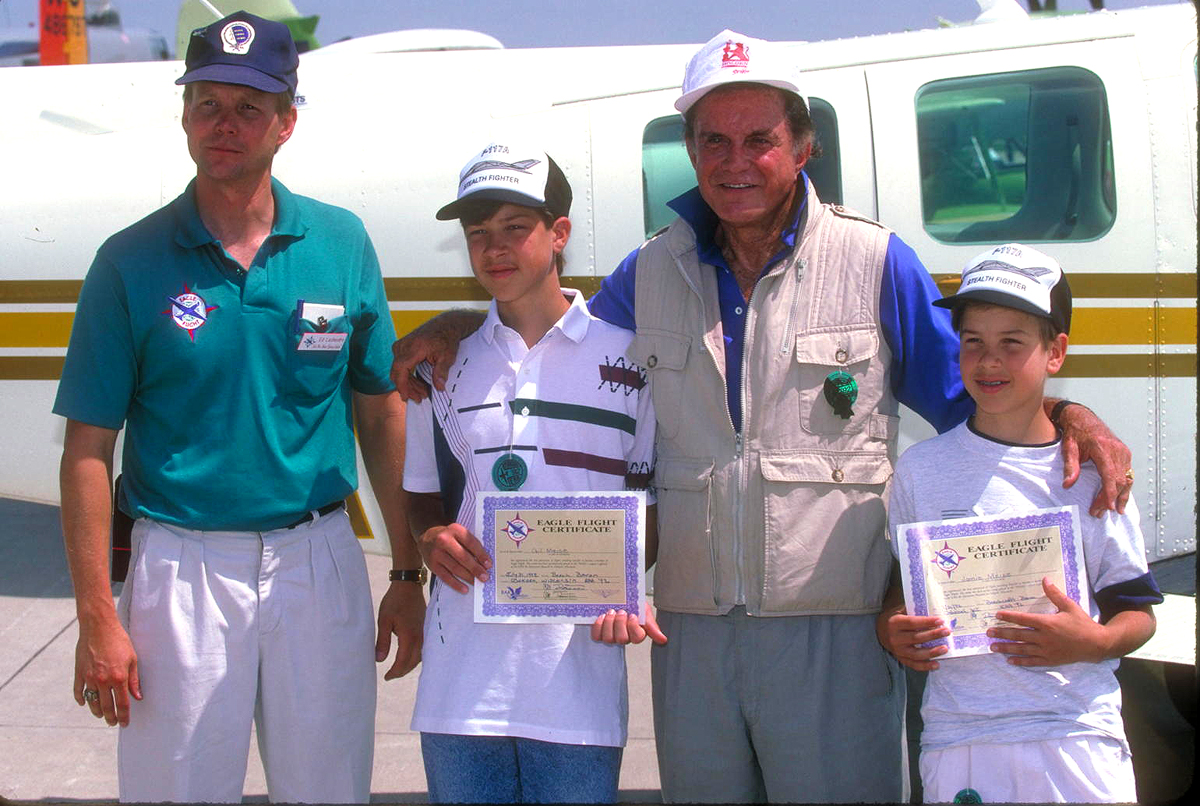By Henry M. Holden

L to R: The first Young Eagles director, Ed Lachendro, Young Eagle Gil Meise, Cliff Robertson and Young Eagle Jamie Meise pose after the boys’ first flight. Robertson served as chair from the program’s beginning through 1994.
As the Young Eagles program enters its 16th year, former Young Eagles are now becoming Young Eagles pilots. Bradley Bormuth’s father was a pilot in the Young Eagles program at Experimental Aircraft Association Chapter 731 in North Carolina. Part of his business also involved flying to customer locations in the state.
“When I was small, we flew on a few trips to visit family in the Illinois and Indiana areas,” said Bormuth. “I was never really introduced to flying; it was more like I was around airplanes. He never let me fly the airplane.”
On Sept. 2, 1995, his father took him up for a Young Eagles flight at Hickory Regional Airport (HKY).
“He let me fly the airplane for awhile, and I really enjoyed it,” said Bormuth. “Ever since that flight, I thought about flying.”
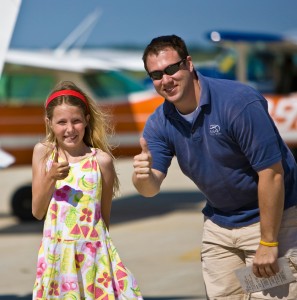
New Young Eagle Caitlin Rowe and pilot Chris Hibben both give her experience thumbs up at the end of Rowe’s first flight. She was part of the one million young people to fly in the Young Eagles by December 2003.
Bormuth didn’t just think about it. He decided to begin flight training.
“My life changed that day; the flight gave me something to look forward to,” he said.
That year, Bormuth went for his first flight lesson at HKY.
“My flying was on and off until I was 15,” he said. “I had my driver’s permit and had to be accompanied by an adult when I drove to the airport.”
He soon became more serious about flying.
“Before I turned 16, I was flying about every other day,” he said. “I soloed on my 16th birthday and had my license shortly after my 17th birthday.”
Bormuth enjoyed flying so much he began looking at the qualifications needed for an aviation career.
“I knew I’d need more than a private ticket, so I continued past my private pilot’s license and now have my commercial and instructor’s ratings,” he said.
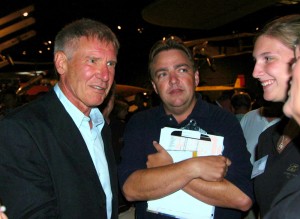
Steve Buss, executive director of Young Eagles, looks on as Harrison Ford greets people during the Gathering of Eagles dinner in 2007. Ford has served as chairman since 2004.
Now a flight instructor with 600 hours, Bormuth is building time to get into corporate aviation.
‘I want to fly business jets or air cargo,” he said.
He’s immersed himself in Young Eagles, flying 73 youth so far. He now serves as HKY’s coordinator for both the Young Eagles chapter and the EAA’s Flying Start program, for those who want to fly but don’t know where to begin.
“I’m working in the program, because I saw a way to inspire others to go into aviation as I did,” said Bormuth. “I think I can give them some advice and help them along the way.”
Through EAA, Bormuth also became interested in airplane restoration. He partially restored his Fairchild 24, which had been beneath six feet of water left behind by Hurricane Frances in September 2004.
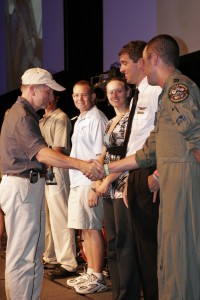
EAA President Tom Poberezny (left) shakes hands with David Marten, a B-1B instructor pilot and former Young Eagle.
During the night of Sept. 7, the Catawba River, which flows through Morganton, N.C., broke its banks and continued to rise. The next morning, the water was nearly 20 feet above flood stage, and the 3,600-foot grass strip lay in the path of the rising floodwaters. When dawn broke, many pilots found their airplanes already under water, including Bormuth’s Fairchild 24, which required a total restoration. With help from a mechanic, the project took almost two years. Bormuth now flies the airplane on his Young Eagles flights.
Genesis Rivas, another former Young Eagle, started in an Aviation Explorers program at Whiteman Airport (WHP) in Los Angeles in 2004. The program’s volunteers help children fill out applications and paperwork for Young Eagles flights. Rivas was 15 at the time of her YE flight on Sept. 11, 2004.
“After seeing these kids going up and the smiles on their faces when they landed, I decided to go up myself,” said Rivas. “It was my first time in a small aircraft, and I was a little bit nervous. The pilot showed us the proper preparations for a safe flight and during the flight, demonstrated how the airplane flew. There was turbulence, but it was a great experience. Even though I sat in the backseat and didn’t take the controls, by the time we landed the only thing I could focus on was getting my license.”
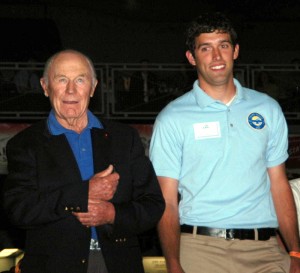
A Young Eagle escorts Gen. Chuck Yeager during the Gathering of Eagles dinner. Yeager held the chairman position from 1995 until 2003.
Rivas said that Young Eagles flight gave her the insight into what she wanted to do with her life. She began flight lessons in 2005 and earned her private pilot’s license in February 2007, accumulating about 82 hours. She’s now majoring in aeronautical engineering at the University of California, Davis. After graduation, she’d like to design commercial airplanes or work for NASA.
“NASA has always been my dream,” Rivas said. “Now, I’m seriously thinking about a double major in aeronautical and aerospace engineering.”
More young people are becoming interested in aviation as the result of EAA President Tom Poberezny’s research in 1991. He commissioned a survey of longtime EAA members. Results showed that few young people were being exposed to aviation. With so many activities vying for their attention, youth weren’t thinking about aviation—for business or for pleasure.
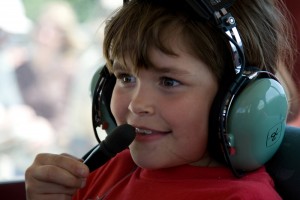
This Young Eagle’s eyes express his excitement about flying in a small plane. EAA wants to harness that excitement and promote careers in aviation.
Poberezny discovered that almost universally all the EAA pilots were exposed to aviation in their preteens, when they rode in small airplanes or had tours of airports.
“We felt EAA could get involved to foster more involvement in aviation,” said Steve Buss, now executive director of the Young Eagles program. “We created the program between December 1991 and May 1992.”
Buss said the original concept was to have a celebrity chairperson lead the program for two years. Academy Award-winning actor Cliff Robertson served as chair from the program’s beginning through 1994.
“Initially, the pilots didn’t have to be EAA members,” Buss said. “But logistics were hard. With EAA, it’s easier to keep in contact with the members and see what they’re doing.”
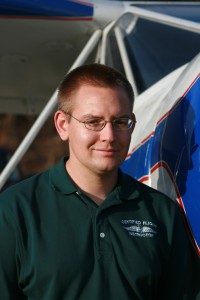
Bradley Bormuth earned his Young Eagles certificate in 1995. Today he’s building time to fly business jets as a career. He also leads the Flying Start program at Hickory Regional Airport in North Carolina.
The first Young Eagles flights took place during EAA AirVenture in Oshkosh, Wis., in 1992.
“We tried to make a big deal about it at the show,” Buss said. “We did flights right before the air show started, when we thought we’d get the maximum attention from the crowd. We featured a different type of aircraft each day; one day it was vintage aircraft, like the Ford Trimotor, and another day, it would be a warbird. About 200 kids flew at the show.”
Gen. Chuck Yeager took over in 1995. He enthusiastically agreed to take the program through one million flights for youth aged 8 to 18 by Dec. 17, 2003, the centennial anniversary of the Wright brothers’ flight.
“There were editorials saying, ‘What’s going on at EAA? They’ll never fly a million kids,'” recalled Buss.
Those critics were wrong.
“In 2003, some of those folks sent us letters, commenting, ‘You made me eat my words, and I’m glad you succeeded,'” said Buss, who has flown 201 Young Eagles himself.
Young Eagles became the world’s largest youth aviation program ever created. Actor Harrison Ford took the chair in 2004.
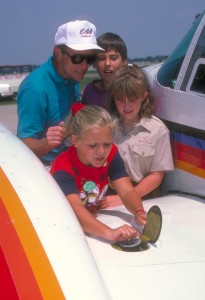
Tom Poberezny keeps a watchful eye on some soon-to-be Young Eagles as they pre-flight the airplane in this 1992 photo.
“Last year, he signed up for another two-year stint,” Buss said. “He’s a great ambassador of the program. He shows that he believes in it, and as a pilot volunteer, he lives it.”
Ford has flown 284 Young Eagles in several different aircraft. To date, more than 1,373,001 kids have flown as Young Eagles.
The Young Eagles program has an unofficial goal of reaching 100,000 young people a year, at an annual cost of about $600,000 for administration, insurance, certificate distribution and public relations. As Young Eagles chairman, Ford helps lead the Gathering of Eagles dinner and auction, an event that raises funds to support the Young Eagles and other education initiatives. The 2007 dinner netted $1.3 million; $938,000 went to the Young Eagles flight program and the rest to EAA museum educational programs.
Buss said the Young Eagles organization is now looking into trying to keep track of participants once they’ve taken their first flight.
“We’ve launched a new student membership program that’s designed as a follow-up to the Young Eagles program,” said Buss. “The membership gives kids the tools necessary to figure out what they want to do in aviation. They can click on the career link, and it’ll display all the different aviation careers. They can ask questions and get career counseling. Those are our first steps to give young people the tools to plot their own course.”
Buss is also looking into the possibility of second flights for Young Eagles.
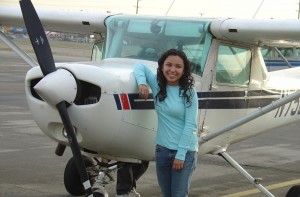
Genesis Rivas is all smiles after her Young Eagles flight. Now a sophomore in college, she says the flight inspired her to major in aeronautical engineering.
“When the kids are done flying, they obviously want to go flying again,” he said. “The first flight’s free, but we’re going to make them earn the second flight by having them complete aviation activities. That’s something we’re developing.”
Activities may include having to plan the first leg of a cross-country flight or report on a book about aviation.
“We want to harness that spark we see in young people,” Buss said.
For more information about Young Eagles, visit [http://www.youngeagles.org].
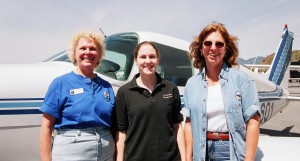
Pilots Ceci Stratford (left) and Ruth Logan flank Young Eagle Erin Thorpe. Thorpe now holds commercial and multi-engine ratings and received a full Navy scholarship to Purdue.











